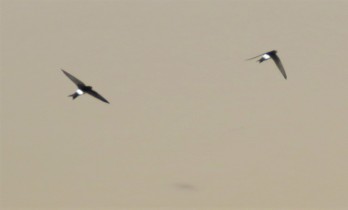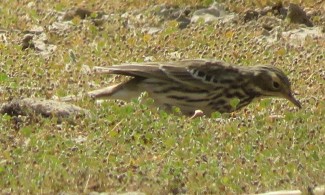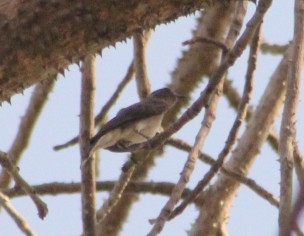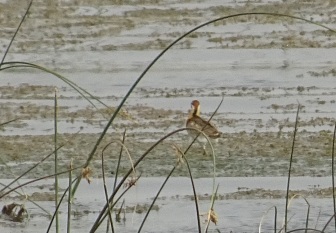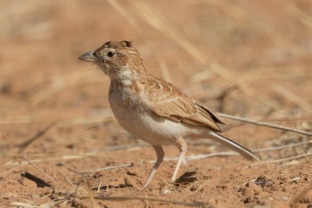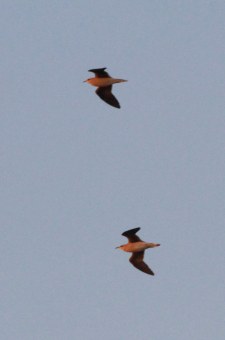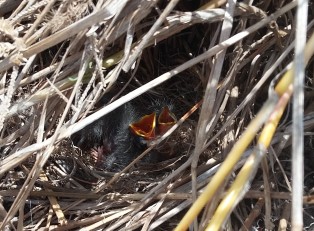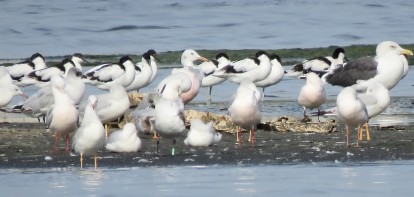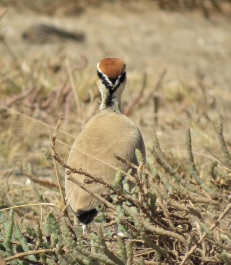Technopole – more gulls, breeding waders & more

It’s been a while since Technopole last featured here, mostly for a lack of birds… With water levels now extremely low – the main pond only has a few shallow patches of water left – and as a result bird numbers are very low. Just a few hundred Black-winged Stilts, and Spur-winged Lapwings, 100-200 Slender-billed Gulls, the odd Audouin’s and a few oversummering Black-headed Gulls, a few lone waders here and there, 6-8 Greater Flamingos and that’s about it. Luckily there’s always something to see at Technopole, and even if overall numbers of migrants are low at the moment, there’s always some of the local species for which it’s now breeding season!
But more about the gulls first.
One of the previous winter’s Mediterranean Gulls remained up to 10 June at least but only allowed for a few poor records shots, rather unusually a 2nd summer (rather than 1st summer) bird. Apparently the first June record for Senegal, of what in the past 10-20 years has become a regular winter visitor in small numbers to the Dakar region. The last Yellow-legged Gull (Goéland leucophée) was seen on 2 May, also a rather late date.
Actually I just realised that I hadn’t shared some of the better pictures of the star bird of the spring here: the 2nd c.y. Laughing Gull, which ended up staying from 25 April until 22 May at least. With the exception of the adult bird this spring (which was seen only twice by two lucky Iberian observers 🙂 on 21-23 April), all previous records were one-day-wonders.
And while we’re at it, here’s the stunning adult Franklin’s Gull in breeding plumage, which unfortunately didn’t linger and was seen just once, on 30 April, at fairly long range hence the hazy pictures:
This bird is from the following day, probably the 2nd summer seen several times between 13 April and 2 May:
Several Black-winged Stilts are still on the nest, but breeding success appears to be low (because water levels are too low, making the nests more vulnerable?). Only a handful of little stiltlets are seen on each visit, and hardly any older juvs. are around. Wondering whether those at Lac Rose may be more successful this year…
A welcome surprise though was a tiny Kittlitz’s Plover chick (Gravelot pâtre), barely a few days old, seen on 10 June. Previous breeding records here were in June 2016 (probable) and July 2012.
Greater Painted-Snipe (Rhynchée peinte) may also be breeding as a pair was seen on 23 June and a male two weeks earlier in the same area (past golf club house on edge of lake near the small baobab!).
And this year there are quite a few Little Bitterns around, quite obviously more than in previous years, with sightings including several singing birds and pairs in at least five locations. I guess the number of territories all over the Grande Niaye de Pikine could easily exceed 10-12 pairs/singing males. Here’s a rather poor picture of a pair seen on our most recent visit, just before it flew off:
Little Grebe (Grèbe castagneux) was once again confirmed to be breeding, though later than in previous years: an adult with a still downy juv. (aged 1-2 weeks?) was on the small pond past the golf course on 10 June, in the same site as in previous years. Previous records in central and northern Senegal were during Dec. – April (read up more about the breeding status of Little Grebe in Senegal & Gambia in this paper that we published in Malimbus last year)
Another nice surprise last Sunday (23/6) was the first Diederik Cuckoo (Coucou didric) of the season in these parts of the country: a singing bird flew high over the pond coming from the Pikine side, then was heard again later on in the tree belt near the football field. Almost as good as hearing the first Common Cuckoo in early April, back “home” in Geneva!
We’re almost there! In the end, there’s been quite a lot to catch up on since early May…
This colour-ringed Gull-billed Tern which I think I’ve mentioned before is indeed from the small colony of Neufelderkoog in northern Germany – the only site where the species breeds north of the Mediterranean region – and as it turns out it’s only the second-ever resighting of one of their birds in Africa. The first was that of a first-winter bird seen in February 2017 in Conakry, Guinea. Our bird ended up staying at least 16 days, from 13 – 28 April. It was ringed on 18 July 2017 by Markus Risch (“WRYY”: white-red/yellow-yellow) and was a late or replacement brood, and the bird was among the latest fledglings of all.
This Common Ringed Plover was around for some time in April / early May, ringed in Norway (details yet to be submitted).
Also on the ringing front, we’re still waiting to hear back for some of the 40-50 Sandwich Tern ring readings Miguel and I managed to make this spring. One of the most recent birds, seen on May 1st, was ringed in June 2017 at Hodbarrow RSPB reserve in Cumbria (UK), and was already spotted on 25/11/17 at Kartong in Gambia (4,720 km, 148 days). While 2nd c.y. birds all stay in Africa during their first summer, third calendar-years such as this one may already migrate back to Europe.
Rounding off the overview with the most recent addition to the Technopole list: African Wattled Lapwing (Vanneau du Sénégal), which surprisingly had not been seen so far, at least not as far as I know – seems like the species actively avoids dense urban areas, since they are regular just outside Dakar but obviously a bit of a vagrant here in town. One was seen flying past, calling a few times, on 10 June.
Species number 239!
Let’s see if we can manage to find 240 in the next few weeks.
The Great Re-Tern

April is Tern month!
From mid-March into May, lots of terns pass through Dakar on their way back home from the wintering grounds further south – some as far as South Africa! – and the first half of April is definitely peak time for many species. When conditions are right, literally thousands of these elegant birds may pass through on a single day, and sites such as Technopole can hold several hundreds of birds at any one time. So much that in the past week, I’ve had the chance to see 12 out of the 14 tern species that are known to occur in Senegal, the only ones missing being Bridled and the rare Sooty Tern.
On Monday 8.4 at Technopole, decent numbers of terns were about, mainly Sandwich Tern (+300, likely quite a bit more) with a supporting cast of the usual Caspian and Gull-billed Terns (the former with several recently emancipated juveniles, likely from the Saloum or Casamance colonies), but also several dozen African Royal Tern, a few Common Terns, at least two Lesser Crested, and as a bonus two fine adult Roseate Terns roosting among their cousins. And as I scanned one of the flocks one last time before returning back home, an adult Whiskered Tern in breeding plumage, already spotted the previous day by Miguel. I managed to read four ringed Sandwich Terns but far more were wearing rings, but were impossible to read.
Yesterday 13.4, we went back to our favourite urban hotspot mainly in order to see if we could read some more of these rings. The main roost is close to the northern shore of the main lagoon, quite close to golf club house, which makes it possible to get close enough to the birds to read most rings. We saw most of the same tern species (except Roseate), with the addition of a fine moulting White-winged Tern and a small flock of Little Terns migrating over our heads. The first colour-ringed bird we saw was actually a Gull-billed Tern, but not the usual Spanish bird (“U83”) ringed in 2009 and seen several times herein the past three winters. This bird was even more interesting, as it was ringed in the only remaining colony in northern Europe, more precisely in the German Wadden Sea. Awaiting details from the ringers, but it’s quite likely that there are very few (if any!) recoveries of these northern birds this far south. It may well be the same bird as one that we saw back in November 2018 at lac Mbeubeusse, though we didn’t manage to properly establish the ring combination at the time.
So, back to our ring readings: all in all, we managed to decipher an impressive 14 Sandwich Tern rings – blue, white, yellow & red! – of birds originating from no less than four countries: Ireland, UK, Netherlands, and one from Italy (to be confirmed). Most of these are chicks that were born in summer 2016 and that logically spent their first two years in the Southern Hemisphere, and are now returning back to their breeding grounds for the first time. In addition, a Black-headed Gull with a blue ring proved to be a French bird ringed as a chick in a colony in the Forez region (west of Lyon) in 2018, while a Spanish Audouin’s Gull was a bird not previously read here. I’ll try to find some time to write up more on our ring recoveries, now that my little database has just over 500 entries!
Others local highlights from these past few days are the Lesser Yellowlegs still at Technopole on 8.4 (but not seen yesterday… maybe it has finally moved on), also a superb breeding plumaged Bar-tailed Godwit, still a few Avocets, plenty of Ruff, Little Stint, Sanderling, Curlew Sandpiper and Dunlin, many of which in full breeding attire. And on 13.4, once again a Franklin’s Gull, but also a rather late Mediterranean Gull and what was probably the regular adult Yellow-legged Gull seen several times since December. Three Spotted Redshanks were also noteworthy as this is not a regular species at Technopole. The Black-winged Stilts are breeding again, and the first two chicks – just a couple of days old – were seen yesterday, with at least two more birds on nests; a family of Moorhen was also a good breeding record.
Full eBird checklist from 13.4 here.
Earlier this week at the Calao was just about as good in terms of tern diversity: again the usual Sandwich Terns which are passing through en masse at the moment, with some LCT’s in the mix, several dozen Common Terns and the odd Roseate Tern hurriedly yet graciously flying past the seawatch spot, and of course more Royal Terns en route to Langue de Barbarie or Mauritanian breeding sites, a lone Caspian Tern, and this time round an even less expected White-winged Tern (and just two Black Terns). Oh and also the first Arctic Tern of the season! The first birds in spring are typically seen at the end of March or first half of April; earliest dates (2015-2018) are 16.3.18 and 25.3.16. The numbers of migrating terns were really impressive here on Saturday 6.4: a rough estimate puts the number of Sandwich and Common Terns passing through at 500 and 1200, respectively, in just two hours.
At Ngor, regular morning sessions have yielded the usual Pomarine and Arctic Skuas, Northern Gannets, as well as a handful of Cape Verde Shearwaters feeding offshore on most days. Sooty Shearwaters passed through in good numbers on 6.4, while last Friday (12.4) was best for Sabine’s Gull: 73 birds in just one hour, so far my best spring count. Also several Long-tailed Skuas and the other day a South Polar or (more likely) a Great Skua was present, a rare spring sighting. All checklists for the recent Calao counts can be found on this eBird page.
Year in review: 2018
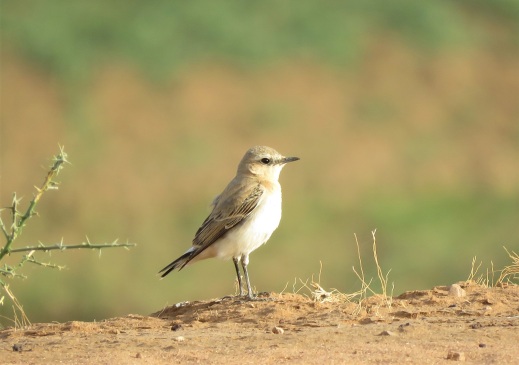
Just like last year we’re bringing our readers a summary of the past year, reviewing some of the ornithological highlights and discoveries made in Senegal, and recycling some of the pictures and posts that appeared on this website during the past 12 months.
2018 certainly has been a busy year!
We’ll start with the best of all: the discovery of what appears to be an isolated (?) population of Horus Swifts (Martinet horus), some 3,000 km from the nearest known breeding sites and more than 1,600 km from the nearest observations of the species (in northern Ghana). This is probably one of the least expected range extensions uncovered in West Africa in recent years, and something we’re of course quite excited (and rather proud!) of. We found these birds during an epic 4-day trip up north together with Frédéric Bacuez and visiting birder Filip Verroens from Belgium, in early January. Needless to say, the year started off with a bang! Read up the full story here and on Frédéric’s Ornithondar blog (in French). A few of these neat swifts were seen again in February by Frédéric and Daniel Nussbaumer, then in October by Vieux Ngom and myself when some 50 birds were present, again showing signs of local breeding and confirming that these birds are most likely residents here, and just last week a group of visiting American birders saw about 25 birds at Gamadji Sare.
Just a few days earlier, in fact on the first day of the year, we’d already found another species new to Senegal: a Meadow Pipit (Pipit farlouse) at the Yene-Tode lagoon just south of Dakar. This find was a bit more controversial – but probably more expected than those swifts! – in the sense that the pipit shows a fairly unusual plumage for Meadow Pipit and certain characters fit Red-throated Pipit better. However, the unstreaked rump and especially the diagnostic call, which was heard loud & clear several times at close range (but unfortunately not sound-recorded), safely rule out Red-throated Pipit, several of which were present in the area at the same time. Full story, description and many pictures here.
Continuing on the same theme, this past year saw the addition of two more species to the Senegal list: Brown-backed Honeybird – which had already been reported from Wassadou in 2015 but was not documented – and Turati’s Boubou. The former was found by Gabriel Caucanas and friends first at Dindefelo, then at Wassadou and later in the Niokolo-Koba NP (more info here), the latter by resident Casamance birder Bruno Bargain back in October. Both were more or less to be expected and back in July we’d actually predicted that the boubou would be found in Casamance some time soon, given that it is known to occur just across the border in Guinea-Bissau. We’ll write up more about this species in due course, and I hope to soon visit the Ziguinchor area again and see (and record) this little-known species – stay tuned!
With no less than four new species, 2018 definitely boosted the national list which now stands at a respectable 678 species; more on this in a blog piece we wrote on the topic of the national list, which contains a link to a handy spreadsheet with all species seen in Senegal, with English, French and scientific names.
Of course there were also the usual lot of vagrants, mostly Nearctic waders in the Dakar region and especially at Technopole, pretty much as usual!
- Common Shelduck (Tadorne de Belon): eight in the Djoudj NP on 17/1 were likely the same group as seen in the Diawling just across the border in Mauritania on 30/12, while one at Technopole on 18-19/2/18 confirmed the small influx that occurred during the ‘17/’18 winter: 8th and 9th records!
- Red-footed Booby (Fou à pieds rouges): one was photographed at Iles de la Madeleine on 26/1 but was only identified later on, while at Ngor up to two adults were seen on several occasions in spring (17/5-22/5, and again on 11 and 22/6) and one was seen twice in autumn (13 & 15/11). These are the 2nd to 4th records for this tropical seabird, which was seen for the first time in October 2016 only.
- Cinereous (=Black) Vulture (Vautour moine): an imm. west of Fatick on 30/1 and one (different bird) on 26/2 near Sagata, east of Kebemer. These observations coincide with the first records for The Gambia (Feb. ‘18) and Mauritania (Dec. ‘17). We also reported the first record of the species, which had not yet been published so far – more details on the status of this increasing Palearctic vagrant in this piece.
- American Golden Plover (Pluvier bronzé): one at Technopole on 8 April, followed by two autumn birds, at lac Mbeubeusse on 3/11 and barely a week later a different bird at Pointe Sarene near Nianing on 9-10/11. Read more on this species in Senegal here.
- European Golden Plover (Pluvier doré): one at Île de Saloulou (Basse Casamance) on 3/1.
- Lesser Yellowlegs (Chevalier à pattes jaunes): the 8th record was one at Technopole seen by a visiting birder on 8/2 and relocated on 19/2
- Baird’s Sandpiper (Bécasseau de Baird): the second for Senegal (and first properly documented) was found at Technopole on 25/3 and seen again on 8/4.
- Buff-breasted Sandpiper (Bécasseau rousset): two birds stayed for a remarkably long time at Technopole, being present from 13/1 (at least one) up to 19/2 at least, then again on 25/3 though this was probably a new bird given that regular visits earlier in the month failed to relocate the two long-stayers; these are the 8th and 9th records.
- Red-necked Phalarope: (Phalarope à bec étroit): one at Djoudj on 27/2 is the 6th record at least, though it’s quite possible that the species is a more regular visitor than the handful of confirmed records suggest.
- Franklin’s Gull (Mouette de Franklin): one was seen five times between 20/5 and 20/9 at Technopole; we summarised the status and trends of the species in this post.
As usual there are also several African vagrants to be reported, such as Lesser Jacana (Jacana nain) seen on 31/1 and 17/2 (three birds!) at Médina Afia near Manda, Kolda dept., and at Ross Bethio on 15/7 – there are only a handful of previous records, including just one in the north (more on status of this species in this post by Ornithondar). A Pharaoh (= Desert) Eagle-Owl (Grand-duc ascalaphe) filmed at Richard Toll on 20/1 was the third record. Six Senegal Lapwings were found at Kamobeul (Ziguinchor) on 30/9 – apparently the first record in 38 years! Three other species with uncertain status in Senegal – true vagrants or scarce but regular visitors? – were seen in the Niokolo-Koba area: Mottled Swift in February and June; a Forbes’s Plover in June and an Ayres’s Hawk-Eagle on 6/3 (Martinet marbré, Pluvier de Forbes et Aigle d’Ayres) .
A special mention goes to the Kordofan Lark (Alouette du Kordofan) that was photographed at Richard Toll on 1/3 by a group of lucky Belgian birders; this is the first record in several years, and the first pictures to be made available online for this species, prompting us to discuss ID criteria and status in Senegal of this enigmatic Sahel special, see this blog piece co-authored with Simon Cavaillès – by far the most read article on the blog, with more than 500 views since its publication in April.
Several winter visitors were seen in higher than usual numbers or reached areas further south than their usual wintering grounds, such as Short-eared Owl (Hibou des marais; seen in six locations during January-March including a group wintering at Technopole, following the influx in Nov.-Dec.). Other scarce winter visitors included a Little Gull (Mouette pygmée) at Ngor on 12/1, while a group of five Cream-coloured Coursers (Courvite isabelle) near Maleme Hodar (Kaffrine) on 1/3 were possibly the southernmost record ever. Other examples include a Spectacled Warbler (Fauvette à lunettes) near Kaolack on 3/3, a “Desert” Grey Shrike (now surprisingly lumped again with Great rather than Southern Grey Shrike; Pie-grièche grise) in the Boundou reserve on 15/3, and five House Buntings (Bruant du Sahara) at Richard Toll on 1/3.
As usual, a few birds were spotted outside of their regular range in the country: several Pallid Herons on the Cap-Vert peninsula; an African Hawk-Eagle that gave us a bit of an ID challenge at Popenguine (3/11); a Greyish Eagle-Owl photographed at Trois-Marigots on 10/1 (only a couple of previous records from N Senegal, see story on Ornithondar); a Grey Phalarope on 25/2 at Médina Afia (a rare inland record!); a singing Klaas’s Cuckoo near Dagana on 6/10; a Broad-billed Roller at Bango (Saint-Louis) on 31/8; Grey-rumped Swallow at Technopole (7/7); an early Lesser Whitethroat at lake Tanma on 25/9; a Cricket Warbler near Gueuol (north of Kébémer) on 21/11 (Aigle fascié, Grand-duc du Sahel, Phalarope à bec large, Coucou de Klaas, Rolle violet, Hirondelle à croupion gris, Fauvette babillarde, Prinia à front écailleux). In the Djoudj, a Brown Snake-Eagle was reported on 5/12. Familiar Chat and Green Turaco were reported from the Niokolo-Koba NP for the first time, where further observations of Mali Firefinch were made (Traquet familier, Turaco vert, Amarante du Koulikoro). Several species were found for the first time in Casamance, including Glossy Ibis, Singing Bushlark, Plain Martin, Great Reed Warbler – details will follow shortly on this website (Ibis falcinelle, Alouette chanteuse, Hirondelle paludicole, Rousserolle turdoïde). Away from the better known wintering grounds in the north of the country, an Iberian Chiffchaff (Pouillot ibérique) was singing at Wassadou on 25/2, and the Technopole bird found on 31/12/17 continued its presence until 7/1 at least.
New breeding records include what appears to be the first confirmed breeding for the Dakar region of Little Tern in June at Lac Rose with at least 14 nests; in the same location we found a nest of Plain-backed Pipit, while a Quailfinch at lac Mbeubeusse on 18/11 suggests that the species may be breeding in the niayes region (Sterne naine, Pipit à dos uni, Astrild-caille). Successful breeding of White-backed Night-Herons (Bihoreau à dos blanc) was confirmed in two locations in Casamance and breeding is also likely along the Gambia river at Wassadou where Pel’s Fishing Owl (Chouette-pêcheuse de Pel) must also have bred. Black-winged Stilts (Echasse blanche) bred once again at Technopole where low water levels created decent conditions in April-June. And a nice breeding record was that of a female Standard-winged Nightjar found incubating two eggs at Pointe Sarène on 4/8 (Engoulevent à balanciers).
A few unseasonal visitors were noted, e.g. early Marbled Ducks and a Black-necked Grebe near Djoudj on Oct. 6th, Western Olivaceous and Melodious Warblers as well as a Woodchat Shrike and even two European Bee-eaters in June; an adult Sabine’s Gull at Ngor on 30/7 (first July record it seems?), and summer Yellow-legged Gulls at Lac Rose (Sarcelle marbrée, Grèbe à cou noir, Hypolaïs obscure et polyglotte, Pie-grièche à tête rousse, Guêpier d’Europe, Mouette de Sabine, Goéland leucophée). Up north, a White-throated Bee-eater and a Pygmy Sunbird were photographed in January near Saint-Louis (Guêpier à gorge blanche, Souïmanga pygmée).
We also continued our seabird migration monitoring efforts during 2018, both in spring and in autumn. Spring migration was summarised in two posts (covering April and May) but the autumn totals are yet to be published. Highlights included decent numbers of Long-tailed Skua (500!) and Grey Phalaropes (1,256!) seen in August when fairly strong north-westerlies created ideal conditions to see these highly pelagic migrants from the coast; both species saw new day records for West Africa it seems. Other good ones included at least 19 Barolo/Boyd’s Shearwaters in Aug.-Sept., a Sooty Tern on 17/9 and several Bridled Terns, while Great Shearwaters passed through in modest numbers around mid-November (Puffin de Barolo/Macaronésie, Sterne fuligineuse, Sterne bridée, Puffin majeur). A pelagic trip on October 1st yielded reasonable numbers of Wilson’s Storm-Petrels (Océanite de Wilson), some shearwaters and skuas, but no rarities this time round. A visiting birder was lucky to see a White-faced Storm Petrel on 3/12 at Iles de la Madeleine, while an observation of Band-rumped Storm Petrel was reported far offshore off Saint-Louis on 25/9 (Océanites frégate et de Castro).
On the ring recovery front, we managed to read some 100 colour rings, mainly of Audouin’s and Slender-billed Gulls (41 & 19, resp.) but also several Greater Flamingos from Spain, a Common Ringed Plover from Portugal, and the first mentions of Avocet in our database (two birds from Spain) as well as a French Mediterranean Gull (“RV2L”) which appears to be the first recovery of this species from Senegal (Goélands d’Audouin et railleur, Flamant rose, Grand Gravelot, Avocette, Mouette mélanocéphale). I now have some 420 ring recoveries in my little database: maybe this year I’ll find time to write up some of the key findings.
A few blog posts on birding sites and other topics were published in 2018, namely the following:
- Senegal as a destination for birders, written up by Paul Robinson following his visit to the UK Bird Fair in 2017
- Blog posts on the birds of Dindefelo and Wassadou following visits to these two major birding hotspots in the south-east of the country
- The Casamance Bird Atlas by the association APALIS
- Birding the Niokolo-Koba: guest blog by John Rose and Dimitri Dagone
- The formal protection of Technopole back in October was of course a major event
- A xeno-canto audio guide to the birds of Senegal
- Last but certainly not least, the last blog piece of the year covered the description of a new species of Square-tailed Drongo
We’ve also been pretty active writing up more formal pieces on birds in Senegal, with several articles published in 2018. This post is actually getting a bit too long so I’ll write about these recent publications in a forthcoming article. For now, go out birding!
Finally, thanks to all our readers for their support and encouragement throughout the year, which has seen a further increase in number of page views (almost 25,000) and website visitors. Oh and do let me know if I forgot anything in the above review, which is just an informal overview – nothing official here!
Technopole update, Lac Rose & more

Lots going on at Technopole at the moment, and hardly any time to write… pretty much as usual.
So here’s a quick update and a few pics, starting with some of the highlights:
- The two obliging Buff-breasted Sandpipers are still present, seen each time in the area behind the fishermen’s cabin. The country’s 7th or 8th record, and also by far the longest staying birds.
- This may be getting boring now and a bit of a déjà-vu, but yet again a Lesser Yellowlegs showed up in Dakar. This one was photographed on 8/2/18 by J. Dupuy and posted on observation.org; as far as I know this is the 8th record for Senegal and the third for Technopole (after singles in August 2015 and January 2016). Yesterday morning, a visit with French birders Gabriel and Etienne allowed us to relocate the bird, a very nice adult coming into breeding plumage:
- Almost just as good, and another first for Technopole (232 species on the list now), was this Common Shelduck – not totally unexpected given the small influx that took place this winter, but still a very good record and always nice to see this pretty duck showing up on my local patch. Unlike its name suggests, it’s definitely not common in Senegal, as there appear to be only about nine previous (published) records, two of which were also obtained this winter.
- Along the same lines, another scarce species showed up at Technopole recently, possibly still the same as the one I saw at the end of December: a Jack Snipe on 12 & 19/2. Only a few Garganeys are present at the moment, but Northern Shovelers are still numerous these days. At east three Eurasian Teal were with the preceding species (two males on 27/10, and a pair on 10/2).
- Remember that influx of Short-eared Owls? Well it looks like it’s not finished yet, with the discovery of no less than seven (maybe even more!) Short-eared Owls roosting together, on 3/2, by Edgar and Jenny Ruiz (at least two birds were still in the same place on 18/2).
Switching categories now – ring reading! Even with such a diversity and sheer numbers of ducks, waders, terns, gulls to go through, we’re still paying attention to ringed birds. And making very modest contributions to our knowledge of migration strategies, survival rates, and much more – one bird at a time. Since the start of the year we’ve been able to read about 50 rings of more than 40 different birds, mostly Audouin’s, Lesser Black-backed and Slender-billed Gulls, but also a few more original species:
- The flock of 170-180 Avocets that are still present contains at least two colour-ringed birds, both from SW Spain where they were ringed as chicks in… 2005! That’s nearly 13 years for both birds – a respectable age, though it seems that this species can live way longer that that: the record for a British (& Irish) Avocet is nearly 24 years (impressive… though not quite as much as a that 40-year old Oystercatcher!). Interestingly, “RV2” had already been seen at Technopole five years ago, by Simon, but no other sightings are known for this bird.
- A few Black-tailed Godwits are still around though the majority has now moved on to the Iberian Peninsula from where they will continue to their breeding grounds in NW Europe. Reading rings has been difficult recently as birds tend to either feed in deeper water, or are simply too far to be read. This one below is “G2GCCP”, a first-winter bird that hatched last spring in The Netherlands and which will likely spend its first summer here in West Africa. Note the overall pale plumage and plain underparts compared to the adult bird in the front, which has already started moulting into breeding plumage.
- Mediterranean Gulls are again relatively numerous this winter, with some 8-10 birds so far. As reported earlier, one bird was ringed: Green RV2L seen on 21 & 27/1, apparently the first French Med Gull to be recovered in Senegal.
- The Caspian Tern “Yellow AV7” is probably a bird born in the Saloum delta in 2015 – awaiting details.
- The regular Gull-billed Tern U83, ringed as a chick in 2009 in Cadiz province, seems to be pretty faithful to Technopole: after four sightings last winter, it’s again seen on most visits since the end of January.
A morning out to Lac Rose on 11/2 with visiting friends Cyril and Gottlieb was as always enjoyable, with lots of good birds around:
- The first Temminck’s Courser of the morning was a bird flying over quite high, uttering its typical nasal trumpeting call. The next four were found a little further along, while yet another four birds were flushed almost from under the car, allowing for a few decent pictures:
- The now expected Greater Short-toed Larks were not as numerous as last year, with a few dozen birds seen, sometimes side by side with Tawny Pipit. No Isabelline nor any Black-eared Wheatears this time round, but one of the Northern Wheatears was a real good fit for the leucorrhoa race from Greenland (& nearby Canada and Iceland).
- As usual, a few Singing Bush Larks were about, though not very active and as always quite difficult to get good views of as they often remain close to cover, even sheltering under bushes.
- Quite surprisingly, we saw lone Sand Martins (twice), a House Martin, and especially Red-rumped Swallow – the latter a long-awaited addition to my Senegal list. Already on the move, or are these hirundines overwintering in the area?
- A final stop on the edge of the plain, where the steppe transitions into the dunes on one side and a seasonal pond (now dry) on the other. Here we found a couple of species that I’d seen in the same spot before, particularly two that have a pretty localised distribution in western Senegal it seems: Yellow-fronted Canary, and Splendid Sunbird. Also seen here were another Red-necked Falcon, Mottled Spinetail, Vieillot’s Barbet, etc.
- And plenty of gulls by the lake! First time I see this many gulls here, with at least 800 birds, mainly Audouin’s (ca. 350) and some 500 Lesser Black-backed Gulls. Lots of ringed birds of course, but most were too far and we didn’t take the time to go through the entire flock.
And elsewhere in Dakar…
- A “Pallid Heron” Ardea (cinerea) monicae was found by Gottlieb and Cyril at Parc de Hann on 13/2 (but not relocated yesterday…). A rare Dakar record!
- Seawatch sessions at Ngor continue to deliver good species, most notably good views of several European Storm-Petrels these past couple of weeks. Lots have been seen along the Petite Cote (Saly, Somone, Toubab Dialaw) recently, and especially at the Gambia river mouth where several dozen birds were counted.
A bit of news from our little neighbour

It’s about time we reported some news from Gambia on this blog.
Clive Barlow’s recent appointment as official bird recorder for The Gambia is a great excuse to do so. Given its peculiar enclaved geography – just like my home country, a bit of an accident of history, Gambia has always had close ties to Big Brother Senegal, in many ways – cultural, religious, linguistic, ethnic, economic… In the same way, Senegal’s and Gambia’s wildlife and ecosystems are of course intricately connected. A key difference, however, is that despite it being just about 6% of the size of its neighbour, The Gambia has a much higher density of resident birders, birding tours, and local guides, and as such is far better covered, ornithologically speaking, than Senegal.
Want some examples to illustrate the connections between the two? Here’s a first one: the wanderings of Abuko, one of several Gambian “Hoodies” that are equipped with satellite tracking devices. As a youngster, this particular Hooded Vulture was a keen traveler, having covered a good deal of central Senegal, Western Casamance (where it seemingly has taken up residence), and upriver Gambia. The map below shows its movements for the past 4 years.
Another example are the Slender-billed Gulls, Caspian Terns, and Royal Terns that breed in Senegal’s Saloum delta, many of which make it to The Gambia at some point. Take for instance Slender-billed Gull “POL” ringed as a chick in June 2014 at the Ile aux Oiseaux, and seen at Tanji Bird Reserve on 16/3/15, 14/4/15 and again the following winter, on 5/2/16. Among the 40+ other recoveries of the Saloum’s breeders in TG, another one is AUF: ringed on 15/6/15 at Jakonsa (also in the PNDS), it was seen on 26/8/15 at Tanji, and then almost a year later, on 26/6/16, at our very own Technopole.
And now for the very official announcement of Clive’s appointment, by the West African Bird Study Association from Gambia (WABSA):
“As from 15 Oct 2017 WABSA is pleased to appoint Clive R Barlow as the voluntary Country Recorder for bird observations in The Gambia. WABSA intends an annual Gambia bird report & general update of activities for presentation to DPWM & this publication will then will be accessible to all resident ornithologists & visiting birders. The work will also compliment the GIS bio diversity project currently under planning at DPWM. More news of e.g. single species enquiries, colour ring reports, nest/breeding records, will be notified as the project develops. In the meantime various report forms are being developed but feel welcome to email your ad hoc records, trip reports etc past, present & future to CliveRB [email]. Additionally, all related field research activities will involve WABSA and DPWM staff also to partake voluntarily in the absence or presence of funding. ”
So, if you visit TG: please send your records, whether of common birds or rarities, to Clive.
Clive also runs a project on the phenology of Paleartic passerine migrants to The Gambia, running from as far back as 1965 to present, systematically recording the first arrival and last departure dates in the coastal area (Banjul – Tujering). In 2017, we have for instance the last record of Western Olivaceous Warbler in 29/03, with the first return bird as early as 28/07, while Subalpine Warbler was last seen on 26/04 and had a first returning bird on 06/10; Common Swift 14/04 & 30/07, etc. The first Common Nightingale of the autumn was heard singing on 13/11.
Watch this space for more trans-border collaborations and publications! (next up: Great Shearwater in Senegambia, status of Kelp Gull, and more!).
I certainly hope to make it to TG some time soon, to see what’s all the fuss about and visit some of the hotspots such as Tanji, Kartong, Abuko Forest, Kiang West and so on.
And meet CrB in real life 😉
For now, I’m off to the Djoudj, Langue de Barbarie, Lompoul and Somone. Happy holidays!
(Featured image: “Beach Boys” by CrB, 2017)


















